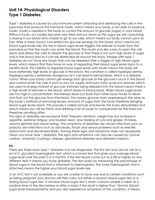Unit 14: Physiological Disorders
Type 1 Diabetes:
Type 1 diabetes is caused by your immune system attacking and destroying the cells in the
pancreas that produce the hormone insulin, which means your body, is not able to produce
insulin. Insulin is needed in the body to control the amount of glucose (sugar) in your blood.
Without insulin, our bodies become very tired and run down as the sugar we are consuming
is staying in our blood and unable to go to our cells, which means our body cannot use it as
fuel. After a meal, food is converted into glucose (energy for the body) which means our
blood sugar levels rise; this rise in blood sugar levels triggers the release of insulin from the
pancreas so that the insulin can enter the blood. The insulin acts like a key to open the cell
doors and allows the cells to absorb the glucose so that there is not such high levels of sugar
only in the blood and so it can be distributed all around the body. People with type 1
diabetes do not have any insulin that can be released after a trigger of high blood sugar
levels, which means that they have no way of regulating their blood sugar levels back to a
healthy level. This inability to regulate blood sugar levels with insulin means the body will
have extremely high levels of glucose in the blood, this condition is called hyperglycaemia.
Hyperglycaemia is extremely dangerous as it can lead to ketoacidosis, which is a diabetic
coma. When your body cannot get energy from glucose as the glucose is stuck in the blood
and cannot enter the cells it turns to your fat supply and burns fatty acids into ketones which
are used as energy instead of glucose. Ketones being released into the blood means there is
a high levels of ketones in the blood, which leads to ketoacidosis. When blood sugar levels
are too high in concentration, the kidneys draw out fluids from other body tissues to dilute
and flush out the glucose from the blood. This means glucose starts appearing in the urine as
the body’s method of removing excess amounts of sugar from the body therefore bringing
blood sugar levels down. This process is called osmosis and leaves the body dehydrated and
which means you will be thirsty and drinking a lot of water to compensate for the fluids lost
therefore urinating often.
The signs of diabetes are excessive thirst, frequent urination, weight loss but increase in
appetite, extreme fatigue, and blurred vision, slow healing of cuts and grazes, itchiness
around genitals and mood swings. The symptoms of diabetes are urinary infections such as
polyuria, skin infections such as abscesses, thrush and sexual problems such as erectile
dysfunction and decreased libido. Having these signs and symptoms does not necessarily
mean you have type 1 diabetes, the signs and symptoms can also be caused by cancer,
coeliac, anaemia, Cushing’s disease, gestational diabetes and diabetes insipidus.
P3 -
There are three ways type 1 diabetes can be diagnosed. The first test your doctor will do is
an A1C glycated haemoglobin test, which is a blood test that gives your average blood
sugar level over the past 2 or 3 months. If the test results come out as 6.5% or higher on two
different tests it means you have diabetes. The test works by measuring the percentage of
blood sugar in the blood that is attached to haemoglobin, the more haemoglobin that is
attached means the higher your blood sugar levels are.
If an A1C test is not available or you are unable to have one due to certain conditions such
as being pregnant your doctors will then carry out either a random blood sugar test or a
fasting blood sugar test. A random blood sugar test is when a blood sample is taken at a
random time of the day before or after a meal, if the result is higher than 12mmol (blood
sugar level measurements) and you also experience symptoms of the condition, it means






